The Church today is a divided church – some say the hour on Sunday morning when people are at church is the most segregated hour of the week. Joe Barndt’s book “Becoming an Anti-Racist Church” is enlightening me about the history of how this came to be. The Church split into the Ruler's Church and the People's Church originally when Constantine declared Christianity to be an officially sanctioned religion of the Roman Empire in 313 A.D. The Protestant Reformation did not fix the problem but divided the Church further. The divide of the Ruler's Church and the People's Church still persists and exists among both the Roman Catholic and Protestant churches, though it can be complex to see. There was not unanimity among the Church when the Ruler’s Church in Europe set out on its conquest of colonization – closely tied to the conception of superiority of the white race and the perpetuation of slavery. However, in general The Ruler's Church has a triumphal theology, “thanking God for blessing colonial enterprises with success, security, and material possessions” and is quick to “view poverty and other expressions of human suffering…as temporary conditions that could be overcome by individual effort, or responded to with charitable assistance,” while the People's Church uses the theology of the cross and identifies with suffering and oppression.
Francis and Clare of Assisi and Agnes of Prague, meanwhile, helped to heal the divide even before the Protestant Reformation, and did so without leaving the Roman Catholic Church.
On a Franciscan retreat last weekend, I learned from Sister Kathy Osbelt about Agnes of Prague’s communication with Clare of Assisi in the 13th century. Agnes of Prague was set to marry a king, and then an emperor, and she declined both to join Clare’s order, the Poor Ladies as they were known at the time. Her cousin was Elizabeth of Hungary (the patron saint of the Secular Franciscans). Clare wrote letters to Agnes, who was eventually given the “privilege of poverty” after her brother, King Wenceslaus I, wrote to Pope Gregory IX asking him to give her what she was asking for if he wanted to maintain good relations with the kingdom. The Pope had not wanted to lose the land her material privilege afforded the church, but acquiesced.
The privilege of poverty made it harder for Francis and Clare and their followers to live a life of comfort, but made it easier to live as true brothers and sisters to all. As Jesus said, “my yoke is easy, and my burden light” (Mtw 11:30). Fraternal life is supposed to break down socioeconomic barriers to full participation in communal life. The Franciscan myths of inclusion, dignity and beauty which Fr. David Couturier describes, are an antidote to the metaphor that the current political administration uses of the United States as “a fortress nation in peril” and “immigrants as ‘danger,’ ‘disease’ and ‘criminals.’”
How can we take history together with Franciscan idealism to build a more inclusive world? If the Ruler’s Church recognizes the value of Christ’s message, can it agree to partner with the People’s Church to truly triumph over the evils of oppression?
Sunday, August 5, 2018
Sunday, July 22, 2018
Breaking Bread and the Franciscan Solidarity Tables
I would like to share two of Fr. Richard
Rohr’s daily meditations from this weekend, as I think they are particularly
relevant to the Franciscan Action Network’s efforts to build Franciscan Solidarity
Tables in cities across the United States. I have shared some commentary in between as
well.
Fr. Richard Rohr shared in his daily meditation on July
21st:
Again and again,
Jesus demonstrated one of the simplest, surest ways to connect with others
across differences: share a meal. Somehow in eating together our barriers
lower. We sit across from and beside one another, at the same level. Perhaps we
recognize the familiar in each other, the universal need to be fed.
He encourages us
to “participate in some form of breaking bread… as a contemplative practice, a
way to open your heart and be deeply present to someone else.” He then shares,
The People’s
Supper, a nonprofit “building community through better conversations,” offers a
helpful framework for purposeful meals. Their goal is “to repair the breach in
our interpersonal relationships across political, ideological, and identity
differences, leading to more civil discourse. And, we plan to do it in the most
nourishing way we know—over supper!”
This isn’t about
a political party, or what is or isn’t happening in Washington. It’s about us,
and our relationship to one another. Too often, we exist in echo chambers and
see each other as monoliths: one-sided stereotypes who can be reduced to a
single word or phrase.
Instead, we want
to go beneath the headlines, to see each other as real people with real
struggles, real fears, real hopes, and real dreams.
Suppers are a
place where we can come together over one of humanity’s most ancient and simple
rituals. A place where we can share meaningful stories, good food, and a sense
of community. A place where we can build understanding and trust.
We invite you to pull up a chair.
The People's Supper helps hosts create a safe, comfortable space. You don't have to be a professional chef! Potlucks - where everyone brings something to share - are the best way to build community.
This is precisely what the Franciscan Action Network is working to
build: Franciscan Solidarity Tables where all are welcome and we can build
understanding and trust and work for justice for the marginalized. This frequently means engaging on political
issues, which Fr. Richard quotes Peter Armstrong in saying that this is necessary
to do for us as Christians to be able to claim we “have anything to do with
Jesus.”
We need not seek
division and further polarization; however, we can continue to engage in tough
debate and conversation across dividing lines, expressing our own deeply held
convictions and being willing to be changed by our encounter with the other,
because that is the way that Jesus engaged with others.
He also quotes Parker Palmer on the topic:
When we forget
that politics is about weaving a fabric of compassion and justice on which
everyone can depend, the first to suffer are the most vulnerable among us—our
children, our elderly, our mentally ill, our poor, and our homeless. As they
suffer, so does the integrity of our democracy.
On July
22 in his daily meditation, Fr. Richard discusses “The Shape of the Table.” He
starts with the Eucharist’s relevance to the conversation about bringing people
together around a table in today’s context: “the Eucharist is an invitation
to socially experience the shared presence of God, and to be
present in an embodied way.”
First, let me share some context. In Jesus’ time, the dominant
institution was the kinship system: the family, the private home. That’s why
early Christians gathered in house churches, much different from the typical
parish today. In Matthew’s Gospel the word house is used many
times. Jesus is always going in and out of houses (as in 8:14, 9:10). What
happened around the tables in those houses shaped and named the social order.
Table friendship ends up defining how we see friendship in general.
Jesus often used domestic settings to rearrange the social order.
Nowhere was that truer than with the meal—with whom, where, and what he ate.
This is still true today, more than we might imagine. (Another example of Jesus
changing the social order is in the relationship between employers and
workers.) Jesus’ constant use of table relationships is perhaps his most
central re-ritualization of what family means. Note that he is always trying to
broaden the circle (see Luke 14:7-24 for three good examples). Jesus brought
this all to fullness in his “last supper” with “the twelve.” This was not to
emphasize male fellowship, but the full quorum of the twelve tribes of
Israel. (I know it does not look that way to us now, but the Eucharistic
meal was from the very beginning a gathering of both women and men, which shows
how Christians understood equality.)
Jesus didn’t want his community to have a social
ethic; he wanted it to be a social ethic. Their very way of
eating and organizing themselves was to be an affront to the system of
dominance and power. They were to live in a new symbolic universe, especially
symbolized by what we now call open table fellowship.
This has a particular relevance to food justice and climate change:
In all cultures, sharing food is a complex interaction that
symbolizes social relationships and defines social boundaries almost more than
any other daily event. Whom you eat with defines whom
you don’t eat with. Certain groups of people eat certain kinds
of food. Through our choices and behavior at table, we name and identify
ourselves.
…today a vegetarian (or even vegan) diet has become a conscious choice
for many because they’ve studied the politics of food: who eats meat and who
can’t eat meat; what eating meat is doing not only to our health but even to
the planet. Researchers surmise that the meat-heavy Western diet contributes to
one-fifth of global emissions on our planet. Zen master Thich Nhat Hanh writes: “As a
spiritual family and a human family, we can all help avert climate change with
the practice of mindful eating. Going vegetarian may be the most effective way
to stop climate change.”
(While overall
there are climate benefits to eating less meat, there are also health
implications to consider in going completely vegetarian, and it is not
something everyone should do. However,
the majority of people could eat less meat and adopt a “reducetarian” diet for climate and health
benefits. There also a host of complex
economic, cultural, and social factors to consider to be able to answer the
question, “Who sits at my table?” with integrity….to be covered in future dialogue.)
Another element
of breaking bread together speaks to the statement that eating together makes about
immigration policies: when citizens and immigrant families eat together, we are
working to keep families together rather
than break them apart. This is the essence of the movement “Break Bread Not Families.” Breaking bread together with immigrant
families not only allows us to get to know different peoples’ cultures and
cuisines, but also gives us an opportunity to learn about the stories of what
brought people to immigrate in the first place. Were they seeking refuge or
asylum, escaping tyrant governments or violent gangs in their home communities? Were they forced off of their land because
multinational companies started pillaging the land so they could make a profit
off of its resources, thereby leaving the families without a means to grow
food, access clean water, and make a living?
Coming together around the table allows us to hear stories from our
immigrant brothers and sisters and then see if there is anything we can do to
help, both in their current situation such as with food, shelter, or
healthcare, as well as the situations of their home countries, such as through
working with Franciscans International and engaging at the United Nations.
In September 2017
when the New York City Franciscan Solidarity Table preliminarily began meeting,
three of the topic areas people expressed interest in engaging on were
immigration, health/food justice, and climate change. There is certainly overlap between each of
these issues; coming together around a table allows us to discuss the areas of
overlap as well as how we can make progress on achieving justice and continue bringing
more people to the table and building community.
Kelly Moltzen, OFS, MPH, RD is a board member of the
Franciscan Action Network, program manager of Bronx Health REACH, and 2015 Re:Generate
Fellow of the Food, Health and Ecological Well-Being Program of Wake Forest University’s
School of Divinity.
Wednesday, July 4, 2018
Reflections on Lady Liberty and Mother Mary This Fourth of July
I came across this poster in Washington, D.C. at a rally in
support of Muslims, back in January. Six months later, the irony and its
significance hits us like a ton of bricks, as instead of the United States
welcoming the immigrant, children are being stripped away from their parents’
arms and separated at the border.
This week, a
church in Indiana put a statue of the Holy Family inside a cage,
representing an ICE detention center. Much
like Jesus crying out at the end of his life, “forgive them Lord, for they know
not what they do” – it is a wake-up call to those who do not see the
similarities between the life and family of Jesus Christ and those being turned away and treated as less than human today. If
Christianity does not show us how to act in the face of such injustice, surely
we will continue to live in a land of separation and lack of community. As Michael Moore said on The Late Show
with Stephen Colbert, “if we started acting the way we were taught, in
Catholic school, or in Bible school, wherever you went, we will have a
different country, but not until then.”
As with the image of Lady Liberty holding the immigrant
child in her arms in a time of separation of children from families at the
border, a caged Holy Family shows the stark contrast between the principles that
the U.S. was founded upon, and the Biblical call to welcome the stranger and
the immigrant, and the reality of what the U.S. government and immigration
officials are currently doing. Instead
of such hypocrisy, I believe we need to take a deeper look at Mary, the mother
of Jesus. As a woman who brought Christ
into the world who continues to show us how to love and how to live, we would
do much better than to dismiss her importance as many Protestants do. As a willing participant in the co-creation
of life with God, Mary represents a generative capacity of love and abundance we desperately
need to reestablish. Most of the
immigrants crossing borders are doing so because they feel their lives are in
danger, and/or they cannot live off their native lands any longer. Corrupt governments allow corporations to
plunder land and threaten, destroy and contaminate food and water sources in
the name of profit or the fighting over natural resources. But the life-giving
image of Mary, and the generative capacity of Mother Earth, provide us with an
alternative of abundance, nurturing and welcoming.
This 4th of July, as we mourn the failure of U.S.
to stand true to the words holding up Lady Liberty - “Give me your tired, your
poor, Your huddled masses yearning to breathe free,” – may we reflect on how
different the world would be if we took the example of Mary seriously, valuing the
love and generative capacity of the feminine to give, nourish, and sustain
life.
We can all do something.
Seek out a group near you to support that is working in support of
keeping families together. Cayuga Centers has an Amazon Wish List for the children in its care. And the Franciscan
Action Network is asking Franciscan churches around the country to send in
their photos from local Keeping Families Together marches so we can start to build
more unity and momentum. As St. Francis
of Assisi said, “Let us begin again, for up to now we have done little or
nothing.”
THIS IS MY SONG
This is my
song, O God of all the nations,
A song of
peace for lands afar and mine.
This is my
home, the country where my heart is,
Here are my
hopes, my dreams, my holy shrine.
But other
hearts in other lands are beating,
With hopes
and dreams as true and high as mine.
My country's
skies are bluer than the ocean,
And sunlight
beams on clover leaf and pine.
But other
lands have sunlight too, and clover,
And skies
are everywhere as blue as mine.
O hear my
song, thou God of all the nations,
A song of
peace for their land and for mine.
Monday, April 9, 2018
NY Dialogues: Gun Violence, Race and Gender Issues
For years, I’ve willed and participated in efforts to make
my house a space for meaningful dialogue.
Since the end of 2017, I’ve had the joy of having Bina as a housemate, who has
significantly increased the level of commitment to dialogue within the house. We recognize our unique opportunity in New
York to bring people from different backgrounds together under one roof to
share in meaningful dialogue, community and fellowship with one another.
The New York Dialogues started on January 20, 2018 and the second one was held April 8, 2018. Each dialogue has a theme; April's was Gun Violence, Race & Gender Issues.
The New York Dialogues started on January 20, 2018 and the second one was held April 8, 2018. Each dialogue has a theme; April's was Gun Violence, Race & Gender Issues.
About 10 people gathered together and shared thoughts we had
prepared in advance. Sara opened with a candle-lighting; recognizing that
prayer does still matter, despite the emptiness felt in many previous Black
Lives Matter vigils. Our hope for today is for meaningful change to come out of
our discussion.
Other thoughts shared:
·
Poetry: Black Man in America: An Endangered
Species?
·
Corporate power within the gun industry and its
thirst for wealth, going so far as to even resist safety features, including
childproofing, because it fears it will make cost more expensive for a price
sensitive market
·
The U.S. is a signatory on the International
Convention on the Elimination of All Forms of Racial Discrimination, which
means we can drag the U.S. to an international court of justice. Nations were
called to create national programs of action.
·
The UN declared guns are killing people all the
way back in 2001
·
How news agencies systematically choose photos
that demonize migrants by showing them in large groups versus humanizing them
by showing close-ups and eye contact of individual human beings
·
How the world spends $1.4 trillion on weapons
industry and how 55 cents of every dollar we pay in taxes goes to U.S. military
expenditure
·
Breaking down the concept of “good guys with
guns”
·
How one participant’s parents pulled him out of
public school in Georgia after the public schools started arming teachers after
the Columbine shooting, because the parents realized that if there was a
breakout of shots, Black boys might be most likely to be shot first
·
80% of victims of gun violence are women and
children
·
Every minute 20 people are displaced in the
world, so 28,000 people are displaced every day
·
There may be somewhere between 2-4 million Syrian
refugees outside of Syria, but 8 million refugees inside Syria, who no one ever
talks about
·
Books shared included:
o
Uncommon Valor by Melvin Claxton and Mark Puls
o
The New Jim Crow by Michelle Alexander
o
Lethal But Legal: Corporations, Consumption and
Public Health by Nicholas Freudenberg
·
Reflections: While there is a systemic nature of
corporate power, and cycles of violence, there are also reminders of goodness.
And when we appeal to someone’s inherent sense of good, we can overcome violence.
·
We can process our pain through creative means. Syrian
artist Rashwan Abdelbaki from the Artistic Freedom Initiative
shared his art. I was particularly moved by the Last Supper, First Wall painting.
©Rashwan Abdelbaki
Titled: Last Supper .. First Wall
العشاء الأخير .. الجدار الأول
200 x 330 cm
Acrylic On Canvas
NYC 2017
#RashwanAbdelbaki #Art #Painting #NewYork#Virginia #NY #VA #Damascus #Rome #Beirut#Dubai #London #Vermont #Italy #Syria #Lebanon#UK #USA
Titled: Last Supper .. First Wall
العشاء الأخير .. الجدار الأول
200 x 330 cm
Acrylic On Canvas
NYC 2017
#RashwanAbdelbaki #Art #Painting #NewYork#Virginia #NY #VA #Damascus #Rome #Beirut#Dubai #London #Vermont #Italy #Syria #Lebanon#UK #USA
(At first I thought he said "First World"...but
really the meaning isn't much different, as it is in a "First World"
country like the US that our president wants to build a wall.) I am
particularly moved by this piece, because of the striking irony of the
prisoners sitting behind a wall, at the table of the Last Supper. My tradition
of Christianity/Catholicism teaches that the Last Supper was one where Jesus
shared with us how we can partake in His divinity through sharing in His Body
and Blood - a carnal image for sure, but one of ultimate sacrifice, and one
that reminds Catholics of the beauty of the incarnation every time we celebrate
the Mass at church. If those of us who truly believe that Jesus was
communicating about the divinity we can all share with Him in - that each human
being has a spark of the divine and deserves all the dignity and respect in the
world - then what does a painting like this tell us about how well those of us
who are Christians are living out this message? What would Jesus say if he were
alive today and saw this painting? Because the message the painting
communicates seems to me to be pretty much on the mark. There are many
practicing Christians and others who are oppressed, who are prisoners in their
own lives, stuck behind walls or silos of ignorance and fast-paced society that
separate them from human compassion. To me this painting represents the base
communities such as those that liberation theology stands for: Christians and
others who respect Jesus' message, crying out to be heard, to be seen, to not
just be regarded as "other" and treated brutally and often even
killed, but instead treated as unique and dignified human beings who deserve to
be listened to. I pray we can use this and other meaningful art such as this to
spark dialogue for true inclusivity, hope, and change.
Saturday, January 27, 2018
Water and Health in the Bronx: Protecting the Sacred
It is hard to not be awed by the scale and tremendous care that goes into supporting the gigantic system bringing water to New York City and the surrounding counties. Flowing from the Catskill/Delaware Watersheds and the Croton Watershed, approximately one billion gallons of water are consumed in New York City every day, serving 8.5 million residents as well as millions of tourists each year. In all, the New York City Water Supply System provides nearly half the population of New York State with high-quality drinking water.
It is humbling to realize just how dependent all these millions of people are on the water supply functioning the way it is supposed to. Water constitutes about 50-70% of our bodies as human beings. Water from the reservoirs, aqueducts, and street-side sampling stations is quality tested by the Department of Environmental Protection’s scientists, with nearly 630,000 analyses performed on the samples in four state-of-the art laboratories (NYC DEP).
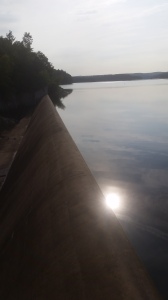
In my own tradition of Franciscan Catholicism, we are called to protect water as a component of creation care, protecting the Earth and our bodies as temples of God. Saint Francis of Assisi heard a call from God to “repair my house, which…is falling utterly into ruin.” While initially he took this as a call to repair a physical church, he eventually came to understand it as a call to repair the institutional Church and the universal house of God, the common home that we all share here on Earth. His spirituality grew to such depths that he came to regard Earth as Mother Earth, and water as Sister Water. By protecting water, we are protecting our health and that of our fellow sisters and brothers with whom we share the Earth. Unfortunately, in many places in the United States and across the world, oil spills from pipelines, contamination from hydraulic fracturing, and runoff from nuclear power plants and industrial agriculture threaten water supplies. Thus, I see the call to watershed discipleship as extremely important for people of faith.

Pope Francis explained the risks of water pollution in his 2015 encyclical, Laudato Si’, which many people of faith are using to make the case for why we should care for our common home. He dedicates a whole section of the encyclical to the issue of water – noting the importance of fresh water for healthcare, agriculture and industry; the prevalence of droughts and water poverty; the outbreak of water-related diseases among the poor; water pollution resulting from certain mining, farming and industrial activities; the phenomenon of water privatization by large multinational businesses; and the link between water scarcity and the cost of food and various products which depend on its use. He also notes, “access to safe drinkable water is a basic and universal human right.”

Yet, my concern about water quality and safety stems not just from the threats modern society and corporate greed pose to water safety. I am also concerned because water is the healthiest drink. I work at Bronx Health REACH, which partners with school districts and a number of faith-based and community organizations to promote water as the best alternative to beverages of poor nutritional quality. In this work, it is necessary to make sure we can point to sources of safe drinking water if we want people to switch away from unhealthy drinks like sodas and drinks high in sugar.
First, I’ll share a little bit about why we are advocating for people to drink more water, and then share about other environmental and health concerns related to our water system. Finally, I’ll mention the work of a number of faith-based and community organizations in and around New York City that work to ensure there is safe drinking water, and that people are accessing it in healthy amounts.
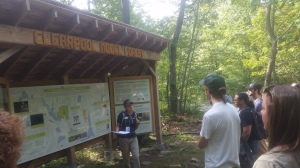
Soda, sports drinks, fruit-flavored drinks, and other sugar-sweetened beverages may sound appealing and some drinks (such as sweetened teas) sometimes get marketed as “natural” and healthy. Society is swamped with marketing campaigns that make these consumer products sound appealing thanks to billion-dollar advertising budgets, but these products are contributing to high rates of diabetes, obesity, and other chronic diseases, with higher and higher rates of these diseases showing up in young children. In turn, this causes rising healthcare costs for dealing with these diseases.
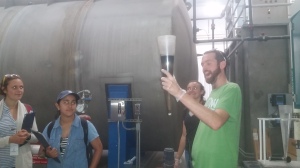
In the Bronx, a third of adults consume at least one sugar-sweetened beverage per day, and over half of children do. A third of Bronx children are overweight or obese, as are two thirds of adults (NYC DOHMH).
Not only do sugar-sweetened beverages contribute to the desecration of our own bodies, but often the industrial processes used to create unhealthy beverages also place undue harm on the environment and make public water sources less and less accessible to the people who need them most. None of this is healthy for people or the economy, but these practices line the pockets of corporate executives. By infusing a sense of value on drinking water, Bronx Health REACH is working to ensure the continued safety of our water supplies.
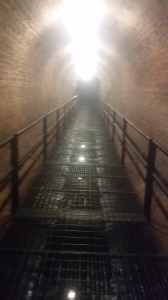
In addition to drinking water directly, water is also used to grow food for our local food system. Some of us in the watershed are teaching children about growing food and getting local food into schools, restaurants, and churches. There is even a farm run by Catholic sisters who sell the produce to local parishes for use in farm shares, food pantries and soup kitchens. Bronx Health REACH has been instrumental in developing a “Bronx Salad” that encourages consumption of culturally relevant foods while also encouraging community members to grow some of the produce locally, such as in community gardens. A feature of this salad is the dressing made from the Bronx Hot Sauce, which is made by a local chef with peppers grown in the Bronx. A version of this salad is becoming increasingly available in NYC school cafeterias, thanks to a partnership between school gardening and Farm to School efforts in NYC. As we seek to develop a regional food system and reduce the environmental impact of our food system, we must also seek to protect the water supplies that nourish the crops.
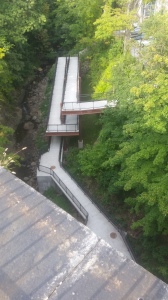
While the water delivered to NYC is pristine and high quality, many New Yorkers remain skeptical of its safety. Therefore, I recently took a tour of the watershed that supplies water to NYC to learn just how safe the water is to drink. The watershed tour guide was immensely knowledgeable, and I became even more deeply aware of the tremendous gratitude and respect we owe to those who work around the clock to make sure that our water is safe. I gained an even greater understanding of the importance of ecology when learning about how the Department of Environmental Protection plants trees upstream from a river to help keep the water pure by filtering out toxins and impurities.
Despite the fact that high-quality water is delivered to NYC, I hear a lot of anecdotal concerns about water safety, at least in the Bronx. Legitimate concerns have been raised since water testing in NYC was examined more critically after the Flint water crisis. It turns out that the pipes bringing water into homes and schools are often old and made of lead, increasing the likelihood of lead leaching into our drinking water. Water samples from 2016-2017 found high levels of lead in some samples of NYC water delivered to schools, leading to outcries about the water’s safety. Even though the NYC Health Department affirms that no cases of lead poisoning have resulted from the high lead levels found in water, any level of lead that makes its way into our bodies is too much. We can reduce the likelihood of lead leaching into our water supply at the individual level by letting the water run before drinking it, only drinking water that comes out of the tap cold (since lead dissolves in hot water), or using special filters that remove lead.
Ideally, we could have well-funded public education campaigns about how to drink water safely, and to replace old pipes with non-lead pipes. But in order to get government and funders to prioritize water safety and public health, we need to tap into our internal spiritual wells, which drive us to improve the quality of life for all, and build increased momentum for the needed changes through advocacy and organizing.
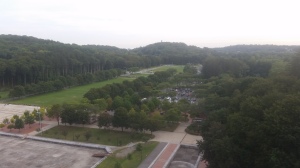
A loose coalition of organizations in the New York City area partner to ensure a safe water supply and to encourage water consumption. Food & Water Watch has policy campaigns to improve pipe infrastructure. The New York City Health Department and Bronx Health REACH have campaigns to encourage water consumption and educate people about the health risks of sugar-sweetened beverages. Water2Kids is a business started by twin children in the Bronx (with the support of their mother) who wanted to see water — instead of sugar-sweetened beverages — marketed to their age group. Groups like Religious Organizations Along the River (ROAR), the Metro New York Catholic Climate Movement (a chapter of the Global Catholic Climate Movement), and the Center for Earth Ethics of Union Theological Seminary work to protect the New York water supply from projects that could threaten the safety of our water. Churches, including Franciscan and other Catholic parishes in NYC, organize film screenings about water and other environmental issues.
As interdependent creatures, human beings must rely on one another and our ecosystems in order to access the most basic of necessities required to sustain life on Earth. Because of our reliance on our watershed and other natural resources, ensuring our water sources remain uncontaminated is vitally essential and part of the call for us to steward creation. As we are interdependent with the Earth to meet our physical human needs, so the parts of the body of Christ are also interdependent with one another. We all need one another in order to make the impacts we want to make.
It can often feel overwhelming to try and address all of the overlapping and interconnected issues related to ensuring safe and healthy water and food supplies. However, as Wendell Berry says in the documentary Look and See: A Portrait of Wendell Berry, we must work on putting the pieces together one at a time, rather than all at once — such as starting with our own watershed. By taking bite-sized steps to address our ecological crisis while continuing to recognize the interconnectedness of issues and our interdependence with the local ecosystem, we can put faith in action by creating a livable, sustainable future for current and future generations.
Reposted from Watershed Discipleship: https://watersheddiscipleship.org/2018/01/27/water-and-health-in-the-bronx-protecting-the-sacred/
Subscribe to:
Comments (Atom)


